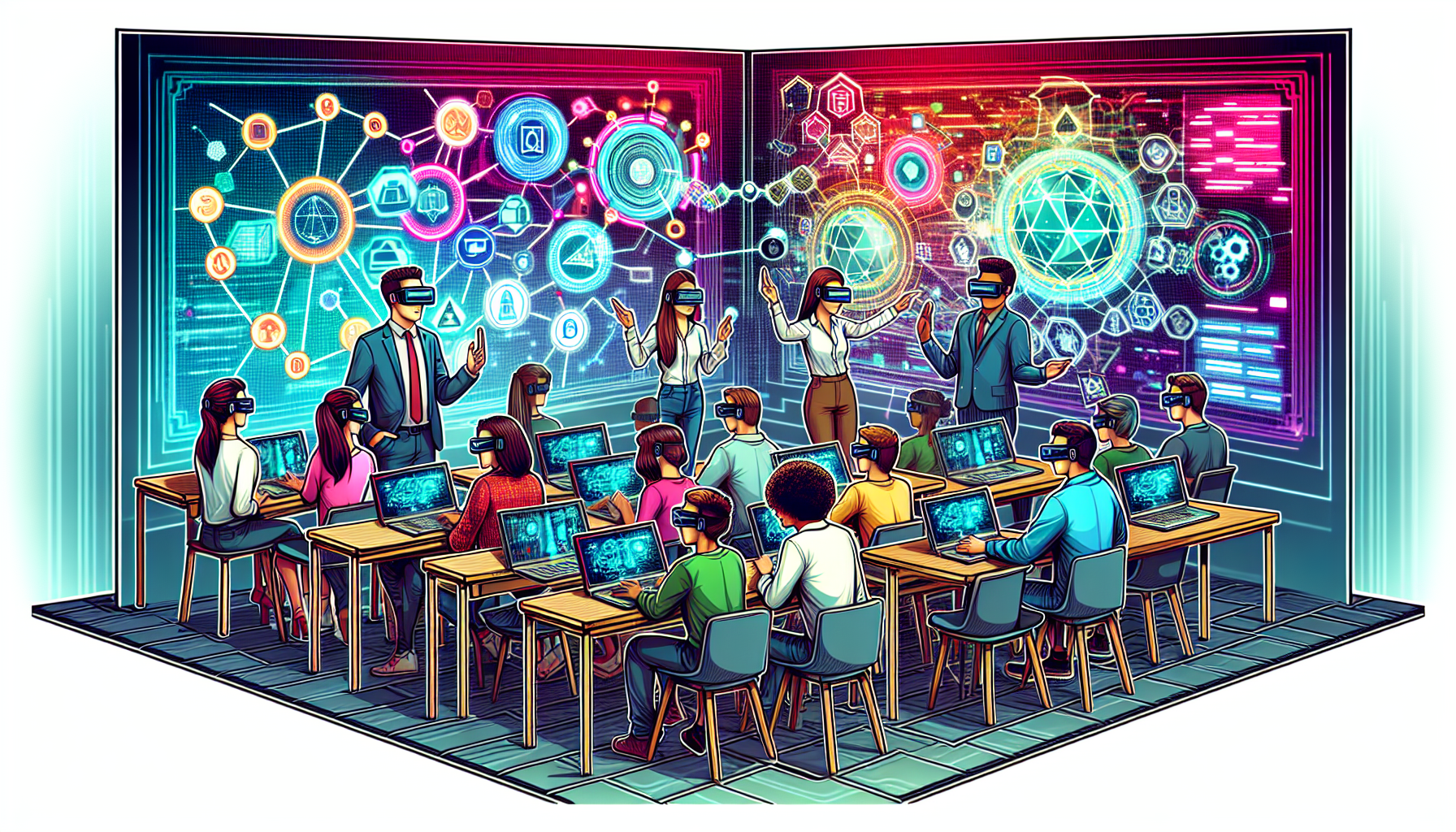Revolutionizing Learning: The Rise of Blockchain Education Platforms
The Fundamentals: Understanding Blockchain Education Platforms
In an era where technological advancements are reshaping industries across the board, education stands at the precipice of a significant transformation, driven by the emergence of blockchain education platforms. But what exactly is a blockchain education platform, and why is it garnering so much attention?
What is a Blockchain Education Platform?
A blockchain education platform is an innovative digital ecosystem that leverages blockchain technology to enhance various aspects of the educational experience. Unlike traditional education platforms, which rely on centralized databases, blockchain education platforms utilize decentralized ledgers to securely store and manage educational data. This fundamental shift introduces a plethora of benefits, from ensuring academic integrity to enhancing student data privacy.
Core Technologies Driving Blockchain Education
At the heart of blockchain education platforms are technologies like blockchain itself—an immutable and transparent ledger system—and smart contracts, which are self-executing contracts with the terms of the agreement directly written into code. Additionally, decentralized applications (DApps) play a crucial role, enabling a variety of educational functions and services to operate in a distributed manner, free from the control of a single entity.
The Fundamentals: Understanding Blockchain Education Platforms
What is a Blockchain Education Platform?
A blockchain education platform integrates blockchain technology into the educational sector to provide a more efficient, secure, and transparent learning experience. These platforms leverage the decentralized nature of blockchain to offer unique features such as immutable record-keeping, tamper-proof certification, and decentralized applications.
Unlike traditional education platforms, which rely heavily on centralized databases and administrative oversight, a blockchain education platform operates on a decentralized ledger. This ledger is shared across several network nodes, ensuring that all transactions and data entries are transparent, permanently recorded, and immutable. The result is an education system that is resistant to fraud, enhances data security, and fosters trust among stakeholders.
Core Technologies Driving Blockchain Education
Blockchain Basics
To understand blockchain education platforms, one must first grasp the fundamentals of blockchain technology. Simply put, a blockchain is a decentralized, distributed ledger that records transactions across multiple computers. Every transaction is stored in a block, which is then added to a chronological chain of previous transactions. This structure ensures that all recorded data is secure, verifiable, and cannot be altered once it is added to the blockchain.
The primary advantage of blockchain technology in education is its ability to guarantee data integrity. Whether it’s recording academic achievements, issuing diplomas, or tracking a student’s learning progress, blockchain ensures that all records are accurate and permanent. This transparency can transform the educational landscape, making blockchain education platforms a revolutionary force in the industry.
Smart Contracts and Decentralized Applications (DApps)
Another crucial component of blockchain education platforms is the use of smart contracts and decentralized applications (DApps). Smart contracts are self-executing contracts where the terms are directly written into code. These contracts automatically execute and enforce the agreed-upon terms when predetermined conditions are met, without the need for intermediaries.
In an educational context, smart contracts can automate various administrative tasks such as student enrollment, fee payments, and certification issuance. For instance, a smart contract can be programmed to automatically award a certificate to a student upon completion of specific coursework and payment of necessary fees. This not only streamlines administrative processes but also ensures that all contractual terms are transparent and immutable.
Decentralized applications, or DApps, are applications that run on a blockchain network rather than on a centralized server. These DApps are pivotal in enabling the seamless operation of blockchain education platforms. They provide a user-friendly interface that connects students, educators, and administrators to the underlying blockchain network, facilitating interactions such as accessing educational materials, verifying credentials, and managing student records.
By combining blockchain technology, smart contracts, and DApps, blockchain education platforms create an innovative and robust ecosystem for modern education. These platforms offer unparalleled benefits over traditional systems, ensuring a secure, transparent, and efficient educational experience for all stakeholders involved.
Benefits of Blockchain in Education
Ensuring Academic Integrity and Transparency
The implementation of blockchain in education brings forth numerous benefits, particularly in enhancing academic integrity and transparency. One of the most significant advantages is the creation of tamper-proof certification and credentialing systems. Unlike traditional methods where records can be altered or forged, a blockchain education platform ensures that all academic credentials are securely stored on a decentralized ledger. Each credential is timestamped and cryptographically signed, making it virtually impossible to alter without detection.
By using blockchain technology, educational institutions can eliminate diploma fraud—a pervasive issue that undermines the value of legitimate qualifications. When a student’s achievements and certifications are stored on a blockchain, employers and other educational institutions can easily verify the authenticity of the credentials by accessing the immutable records. This not only enhances trust in the education system but also protects the interests of students who have genuinely earned their qualifications.
Enhanced Student Data Privacy and Security
Another crucial benefit of blockchain in education is the enhancement of student data privacy and security. Traditional educational platforms often store student data in centralized databases, which are vulnerable to hacks and breaches. A blockchain education platform, on the other hand, utilizes secure data storage and management practices. Since data on the blockchain is encrypted and distributed across a decentralized network, the risk of unauthorized access or data manipulation is significantly reduced.
Moreover, blockchain technology allows for student-controlled access to personal information. Using smart contracts—a key feature of blockchain—students can determine who can access their data and under what conditions. This level of control ensures that students’ personal information is protected and accessed only by authorized parties. For instance, a student can grant a potential employer access to specific credentials without revealing other personal details, maintaining a high level of privacy.
In summary, the incorporation of blockchain in education platforms offers substantial benefits in terms of academic integrity, transparency, and data security. By leveraging the unique characteristics of blockchain technology, educational institutions can create a more trustworthy and secure learning environment for students and stakeholders.
Real-World Applications and Success Stories
Case Studies of Blockchain Education Platforms
The burgeoning domain of blockchain education platforms is not just theoretical but has seen practical implementations with noticeable impacts. Among the frontrunners, several platforms have emerged as exemplary models showcasing the transformative potential of blockchain in education. These platforms have pioneered novel methods to ensure academic integrity, secure data management, and streamlined credentialing processes, thereby revolutionizing traditional learning paradigms.
Notable Platforms and Their Impact
One of the most prominent blockchain education platforms is Credly, which leverages blockchain technology to issue, manage, and verify digital credentials. This platform has enabled educational institutions and employers to issue tamper-proof certifications, thus enhancing trust in the credentialing process. Universities that have adopted Credly’s solutions report nearly 100% reduction in diploma fraud cases, significantly heightening the integrity of their awarded certifications.
Another remarkable example is Blockcerts, an open standard for creating, issuing, viewing, and verifying blockchain-based certificates. Developed by Learning Machine and the MIT Media Lab, Blockcerts’ primary aim is to provide robust, independently verifiable credentials to mitigate the prevalent issue of fake diplomas. The Massachusetts Institute of Technology (MIT) has implemented a system where graduates receive both physical and digital diplomas. This initiative not only expedites the verification process for employers but also provides students with a secured, permanent record of their accomplishments.
Odem is another blockchain education platform making significant inroads. It facilitates seamless interaction between educators and learners, eliminating intermediaries and thus reducing costs. Odem’s smart contracts ensure that once a learning activity is completed and verified, the credentials are automatically awarded and stored on the blockchain. This automation and transparency have resulted in a substantial uptick in user satisfaction and engagement.
Success Metrics and User Testimonials
Quantifying the success of blockchain education platforms involves examining various performance indicators. For instance, Credly reports that institutions using its platform have observed a 60% faster rate of credential verification. This speed not only benefits graduates entering the job market but also bolsters the employer’s confidence in the authenticity of qualifications.
User testimonials often speak volumes about the practical benefits and user-friendliness of these platforms. A graduate from MIT who received a digital diploma through Blockcerts shared, “Having my diploma on the blockchain gives me peace of mind. It’s easily shareable and verifiable, which makes the job application process smoother.” Such testimonials underscore the value these platforms bring to end-users, ensuring the growing adoption of blockchain in education.
Future Trends and Innovations in Blockchain Education
Predictions for Adoption Rates and Technological Advancements
The future of blockchain education platforms looks exceedingly promising, with predictions pointing towards substantial growth in adoption rates. According to a report by HolonIQ, blockchain technology in education is expected to see a compound annual growth rate (CAGR) of over 30% by 2030. This is driven by increasing awareness about the benefits of tamper-proof credentials, enhanced data security, and decentralized learning models.
Technological advancements also play a pivotal role in this growth trajectory. The integration of artificial intelligence (AI) with blockchain can lead to more personalized learning experiences. For instance, AI algorithms can analyze student performance data stored on the blockchain to recommend tailored learning resources and career paths, thereby enriching the educational journey.
Potential Challenges and Solutions for Widespread Integration
Despite the clear advantages, several challenges could hinder the widespread adoption of blockchain education platforms. One key issue is the scalability of blockchain networks. As more transactions (e.g., issuing and verifying credentials) are added to the blockchain, the network could become sluggish. However, innovations such as Layer 2 solutions and sharding are promising approaches to mitigating these scalability concerns, ensuring that blockchain networks can handle increased data loads efficiently.
Another significant challenge is the resistance to change from traditional educational institutions. This challenge can be addressed through comprehensive educational initiatives that demonstrate the long-term benefits of blockchain adoption. Pilot programs and case studies showcasing successful implementations could serve as persuasive evidence to garner institutional support.
Moreover, interoperability between different blockchain systems remains a technical hurdle. Developing universal standards and protocols can promote seamless interaction between various platforms, ensuring a cohesive ecosystem where credentials from different blockchains are interchangeable and verifiable across institutions globally.
In conclusion, the realm of blockchain education platforms is rapidly evolving, offering considerable benefits and innovative solutions to longstanding issues in the education sector. By learning from existing successful models and addressing potential challenges proactively, the education industry stands to gain immense value, catapulting it into a new era of transparency, security, and efficiency.
Conclusion
The advent of blockchain education platforms signifies a transformative era in the educational landscape. With their ability to ensure academic integrity, enhance student data privacy, and foster transparency, these platforms address many of the long-standing issues associated with traditional educational systems. By leveraging core technologies such as blockchain, smart contracts, and decentralized applications (DApps), blockchain education platforms offer a robust, secure, and efficient alternative to conventional methods.
The real-world applications and success stories of these platforms underscore their potential to reshape education. As case studies have shown, institutions that adopt blockchain education platforms witness substantial improvements in credentialing processes, data management, and overall user satisfaction. Furthermore, the evolution of these tools suggests promising trends and innovations that could make blockchain technology a staple in educational frameworks globally.
However, as with any disruptive technology, the journey to widespread adoption entails overcoming several challenges. Issues such as technical literacy, regulatory acceptance, and infrastructural readiness must be addressed to harness the full potential of blockchain in education. Nevertheless, the trajectory is clear: blockchain education platforms are poised to revolutionize the way we learn, certify, and manage educational data, paving the way for a more transparent, secure, and efficient future in education.

